GP26
| Location: Cora Lyn | Aust. Soil Class: Humose-Acidic (and Vertic), Eutrophic, Grey DERMOSOL |
| Northcote Factual Key: Gn 3.41 | Great Soil Group: humic gley |
| General Site Description: Pasture paddock which has previously been cropped. | Mapping Unit: Koo-Wee-Rup peaty clay |
| Landscape Description: Lacustrine plain | Geology: Recent swamp deposits. |
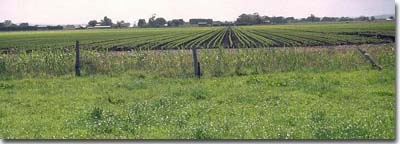 Site GP26 Landscape |
Surface soil:
| A1 | 0-22 cm | Dark brown (7.5YR3/2) fine sandy clay loam (organic); hardsetting surface condition; rusty root channel mottling present; moderate coarse blocky, parting to moderate fine blocky and granular structure; weak to firm consistence moist; pH 5.6; sharp change to: | 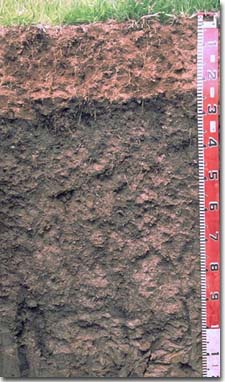 Site GP26 Profile |
| Subsoil: | |||
| B21 | 22-40 cm | Very dark grey (10YR3/1); light medium clay; moderate coarse blocky, parting to moderate medium blocky structure; very firm consistence moist; contains a common (15%) amount of quartz fragments (2-6 mm in size); pH 5.5; clear change to: | |
| B22 | 40-65 cm | Dark greyish brown (10YR4/2) with yellowish brown (10YR5/8) mottles (associated with root channels); medium clay (gritty); contains a common (20%) amount of quartz fragments (2-4 mm in size); pH 5.3; gradual and wavy change to: | |
| B23 | 65-100 cm | Light brownish grey (10YR6/2) with strong brown (7.5YR4/6) mottles (associated with root channels); heavy clay (gritty); parts to strong fine lenticular structure (shiny-faced peds); contains many (15%) quartz and feldspar fragments; pH 4.9; gradual change to: | |
| B24 | 100+ cm | Grey (10YR5/1) with strong brown (7.5YR5/8) mottles (associated with root channels; medium heavy clay; strong medium lenticular, parting to strong fine lenticular structure (shiny-faced peds); contains a few (5%) quartz and feldspar fragments; pH 4.6. | |
Key Profile Features:
- Organic rich surface horizon (ie. humose horizon)
- Lack of strong texture contrast between surface soil and upper subsoil.
- Vertic properties (ie. significant shrink-swell characteristics) in deeper subsoil.
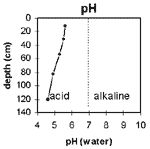 The surface is moderately acid. The subsoil is strongly acid; becoming very strongly acid at 120 cm. | 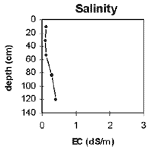 The salinity rating is low for the upper soil profile, and becomes low-medium in the deeper subsoil. |
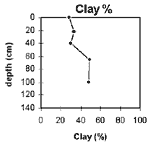 Clay content increases gradually with depth down the soil profile | 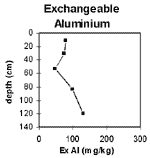 There is a moderate level of exchangeable aluminium in the upper soil profile. The level of exchangeable aluminium increases in the very strongly acid deeper subsoil. |
Horizon | Horizon Depth | pH water | pH CaCL2 | EC 1:5 | NaCI % | Exchangeable Cations | ExAl mg/kg | Ex Ac meg/100g | Field pF 2.5 | Wilting Point pF 4.2 | Coarse Sand (0.02 -0.2mm) | Fine Sand (0.02 -0.2mm) | Silt (0.02 -0.2mm) | Clay (<0.002mm) | |||
ca | mg | k | Na | ||||||||||||||
meg/100g | |||||||||||||||||
A11 | 0-22 | 5.6 | 4.9 | 0.11 | 0.04 | 5.0 | 1.4 | 0.81 | 0.37 | 79 | 32 | 64.2 | 25.5 | 10 | 16 | 21 | 28 |
B21 | 22-40 | 5.5 | 4.6 | 0.09 | 0.03 | 3.5 | 2.4 | 0.21 | 0.49 | 75 | 13 | 35.9 | 14.7 | 18 | 22 | 19 | 33 |
B22 | 40-65 | 5.3 | 4.4 | 0.13 | 0.04 | 2.0 | 2.8 | 0.16 | 0.61 | 48 | 6.1 | 23.6 | 10.9 | 26 | 26 | 17 | 30 |
B23 | 65-100 | 4.9 | 4.3 | 0.28 | 0.09 | 2.4 | 5.1 | 0.27 | 1.3 | 100 | 7.9 | 32.2 | 16.9 | 18 | 18 | 13 | 49 |
B24 | 100+ | 4.6 | 4.1 | 0.41 | 0.13 | 1.8 | 5.7 | 0.37 | 2.0 | 130 | 8.5 | 32.8 | 18.2 | 18 | 18 | 14 | 48 |
Management Considerations:
Note: This pit site occurs on the edge of an asparagus crop. It may not be representative of the whole cropped paddock.
- Whole Profile
- Plant available water capacity (PAWC)is considered to be low-medium (estimated at 90 mm) for the upper metre of this soil profile. This is based on available laboratory data. Effective rooting depth is likely to vary, however, depending on crop type. PAWC should therefore be considered as potential only. Factors which may decrease effective rooting depth and PAWC include: structural degradation due to compaction and variations in soil water table depths. Most of the plant available water will be in the organic rich upper soil profile (estimated at 50 mm for the top 40 cm of the profile).
- The profile is mainly strongly acid throughout. Some vegetables will not grow well in such conditions. Acid soils can also have high aluminium and manganese levels which are toxic to plants. Aluminium becomes more soluble in soils at low pH levels. Exchangeable aluminium levels are only moderate in the upper soil profile at this site. This may restrict the growth of highly aluminium sensitive plant species. High levels of aluminium will also tend to 'fix' phosphorus and make it less available to plants (thus reducing the effectiveness of applied P fertiliser). Raising the pH level of the soil by liming will help reduce the level of exchangeable aluminium. A lime test (sampled across the paddock) is most appropriate for determining the amount of lime needed to raise pH levels. Other factors need to be considered, however, before lime is recommended (eg. species grown, method of application, local trial responses, likely cost-benefit). Many vegetables have a preferred pH range beginning above 5.5; although potatoes have a preferred range of between 5.0 - 6.0. The relatively high levels of organic matter in the upper part of these soils may assist in reducing the effects of aluminium on plants. Organic materials have been known to be effective in reducing the level of active aluminium in soils (Vimpany 1990). Lime application at the soil surface will not significantly affect pH levels in the subsoil.
- Molybdenum deficiency may occur in the strongly acid soil. Lime application will make molybdenum more available to plants. However, if a deficiency occurs, it may be more practical to apply a molybdenum compound to the soil or crop.
- Surface (A) Horizons
- The levels of organic carbon and total nitrogen measured at this pit site are high. Maintenance of organic matter levels is essential in order to sustain agricultural production on such soils. Organic matter is important for enhancing soil aggregation, fertility and water holding capacity. Organic matter levels will build up under pasture but will decline if cropping takes place. Practices such as residue retention, minimum tillage and including pasture rotations can be utilised if cropping takes place in order to retain organic matter. The use of green manure crops (eg. oats, ryecorn, lupins) will also assist in building up organic matter levels between crops.
- The high wilting point value (ie. 26%) indicates that plants will be unable to utilise light rains when the soil is relatively dry.
- Subsoil (B) Horizons
- The organic matter and nitrogen levels are moderate in the upper subsoil, which is beneficial for plant growth.
- Manganese toxicity can occur in strongly acid soils, especially when waterlogging occurs. Susceptible crops include cabbage, cauliflower, lettuce, celery and lucerne (NSW Dept. Agric. 1986). Raising the pH by lime application will assist in reducing any manganese toxicity.
- The deeper subsoil (from 65 cm depth) displays vertic properties (ie. lenticular structure) which indicates that significant shrinking and swelling occurs with wetting and drying cycles. This may result in some disturbance to deeper-rooted plants. The shrinking and swelling may also have engineering implications (eg. disturbance to building foundations and fence lines).
- The presence of root channel mottling in the deeper subsoil indicates that aeration is reduced at times by imperfect drainage conditions. The deeper subsoil is marginally sodic but does not disperse, possibly due to the high aluminium levels. Water movement down the deeper profile may not therefore be significantly reduced.
- This paddock has not been cropped for the last four years and is now under pasture. Previously two crops of potatoes were harvested.


